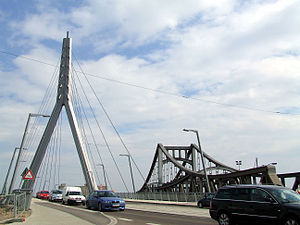Berlin Bridge (Halle)
Coordinates: 51 ° 29 ′ 23 " N , 11 ° 59 ′ 28" E
| Berlin bridge | ||
|---|---|---|
| Berlin Bridge in April 2006 | ||
| use | Road traffic | |
| Convicted | Berlin street | |
| Subjugated | Halle (Saale) freight yard | |
| place | Halle (Saale) | |
| construction | Cable-stayed bridge | |
| overall length | 171 m | |
| width | 20.2 m | |
| height | 73.45 m | |
| building-costs | 42 million euros | |
| start of building | 2004 | |
| completion | 2005 | |
| opening | January 11, 2006 | |
| location | ||
|
|
||
| Above sea level | 111 m above sea level NHN | |
The Berliner Brücke is a road bridge over the railway tracks about 1500 m north of the main station in Halle (Saale) .
history
The bridge was built between 1914 and 1916 with the help of French prisoners of war and was named Hindenburg Bridge after its completion . It was in 1945 renamed Berlin Bridge and stood up to their demolition under monument protection . The three-field bridge , a riveted steel truss structure , was designed and developed by R. Jung and Th. Siemers. With a span of 125 meters in the middle field and 75 meters in the end fields, with a total length of 275 meters, it spans the Halle (Saale) freight station and the mainline tracks leading north from the main station . Although similar to a suspension bridge , the bridle construction corresponded statically to the principle of cantilever beams. At first it was painted light red, later it received a light gray paint, which was refreshed again and again.
The bridge was used by motor vehicles, double-tracked by trams and by pedestrians.
The old bridge was demolished by the end of September 2006 after a new replacement building went into operation. According to the experts, maintaining the bridge would have resulted in costs of well over 10 million euros and extended its service life by only a few decades. The rapid deterioration of the bridge was facilitated by severe corrosion damage caused by smoke and exhaust gases from the steam and diesel locomotives passing under the bridge . Sulfur gases from the thermal power station that has been working in the neighborhood for many decades were also responsible for a not inconsiderable part of the damage. From the point of view of the Halle city planners, a new building was necessary because the stability - even with the load bearing reduced for several years - could only be guaranteed for a short time despite several renovation and additional security measures. For these reasons, the bridge could only be used to a limited extent for several years. Since 1992 there have been regular restrictions on vehicle and tram traffic. Since February 1999, the bridge could only be used with vehicles with a total load of up to 7.5 tons. The only exception here were local public transport buses. Tram operations were also discontinued that year.
On June 21, 2000, the Halle city council decided to build a new replacement building. On Saturday, June 3rd, 2006, the bridge girder still standing was placed on a low-loader and transported away for dismantling. The entire bridge (about 4000 tons of steel) was scrapped. Even a citizens' initiative to preserve the Berlin bridge could not prevent its demolition.
New building
From 2004 to the end of 2005 the bridge was built as a new building. The new Berlin bridge was inaugurated on January 11, 2006. The new bridge was planned and designed by the Grassl engineering office from Magdeburg in collaboration with the architect Uwe Graul from Halle. The construction was carried out by Ed. Züblin AG and Hall-Bau, on whose behalf the steel construction work was carried out by the Donges company.
The transport structure, originally planned for 28 million euros and ultimately costing 42 million euros, bridges the track system with a total span of 171 meters. The cable-stayed bridge , curved in plan, is supported by a central, 73-meter-high and 650-ton steel pylon over 24 cables. For the first time in Germany, the composite steel construction was used for a cable-stayed bridge of this size. The span could be reduced compared to the previous building, as the track systems of the freight station are only used to a limited extent. As part of the eastern approach to the bridge, an earth wall was built up on the former track field.
The bridge received the Saxony-Anhalt engineering award in 2006 as Germany's first cable-stayed bridge.
Web links
- Berlin Bridge (1916). In: Structurae
- Berlin Bridge (2006). In: Structurae
- Collected press releases about the Berliner Brücke
- https://structurae.de/produkte-services/erste-schraegseilbruecke-deutschlands-in-stahlverbund
Individual evidence
- ^ August Klönne Dortmund. 1879 - 1929. Memorandum for the Golden Jubilee on July 1, 1929.
- ↑ Halle city archive; Audiovisual media; S 4.3; History of the Berlin Bridge
- ↑ Archive link ( Memento of the original from October 13, 2007 in the Internet Archive ) Info: The archive link was inserted automatically and has not yet been checked. Please check the original and archive link according to the instructions and then remove this notice.





